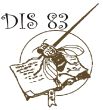
Venkatesh, K. 2000. A novel assay to screen for mutants with strong olfactory defects. Dros. Inf. Serv. 83: 15-178.
|
|
|
|||
A novel assay to screen for mutants with strong olfactory defects.
Venkatesh, K. National Centre for Biological Sciences, TIFR Centre, UAS-GKVK Campus, Bangalore-560 065, INDIA.
A novel OLFACTORY TRAP ASSAY was developed to facilitate large scale
screening of flies with olfactory defects. This was necessitated because the
conventional olfactometers did not permit large scale screening of flies.
For example, Carlson’s trap (Woodard, 1989) and
the Y- maze (Ayyub, 1990) allowed screening of only about 10 flies and 100
flies per run, respectively. In contrast, the new olfactory trap assay reported
here, facilitates screening of at least 500 flies per run. In order to determine
the efficiency of this assay, experiments
were carried out with the wild type strain CS and the mutant- olfDx9 (Ayyub, 1990). olfDx9 is the strongest known olfactory mutant
and is anosmic to multiple odours. Normal fly medium (cornmeal agar medium)
and well fermented yeast were used as attractants in the assay. The results
show a strong response to the attractants by both the wild type and the anosmic
mutant, olfDx9, opening
up a new and simpler way to obtain olfactory mutants having stronger olfactory
phenotypes.
Design of olfactometer:
The olfactometer consisted of a perspex cubical box of internal dimensions
24cm ´
24cm ´
24cm. A shutter provided on one side of the box facilitated opening and closing
of the box. Several orifices on two side walls of the box provided ventilation.
A hole on the top facilitated introduction of flies into the box. Each box
contained four traps placed at the corners of the box. A moist filter paper
on the floor of the box provided humidity. The trap consisted of either normal
Drosophila food (Cornmeal Agar traps) or fermented yeast (Yeast
Traps) in a split bottle (joined together by sticky tape) as attractant. In
case of cornmeal agar traps, about ten grams of yeast granules were sprinkled
on the surface of the medium. In case of the yeast traps, yeast paste was
allowed to ferment for at least 18 hours at 37 °C. The consistency of the yeast paste was
readjusted by adding additional yeast granules. This was then applied to the
wall of the bottle containing 1.0 % sucrose agar medium. The open end of the
bottle was covered with a glass funnel attached to a 1 ml plastic micropipette
tip severed at the pointed end. The funnel allowed the free entry of flies
into the trap but restricted their exit (Figure 1 a and b).
Assay: Three- to five-day-old flies obtained from uncrowded
bottles were used in all the experiments. Flies were starved in bottles containing
moist filter paper for about 18 hours, prior to the test. Starved flies were
then introduced into the box containing traps. The experimental run was for
24 hours in dark and at the end of each run, the persplex boxes with flies
were placed at 4°C to knock out the flies.
The flies were then collected from both the box and the traps and screened
under the microscope. The percentage of flies in the traps was calculated
as given below:
![]() % Flies trapped
= Number of flies in traps X 100
% Flies trapped
= Number of flies in traps X 100
Total number of flies in the box
 |
|
Figure 1 a and b. The experimental set up.
|
Cornmeal agar trap assay: Experiments with Canton-S showed that 96.0% of the flies entered the cornmeal agar traps. About 7.0% of the total flies died during the experiment. About 86.0% of homozygous olfDx9 and 90.0% of the olfDx9 / FM7C were in the traps (Figure 2 a).
Yeast trap assay: Experiments carried out with Canton-S flies and olfDx9 (Ayyub, 1990) showed that both the strains responded to the well fermented yeast. Nearly 96.0% of CS flies were found in the traps. About 6% of the total flies were found dead during the experiment. Surprisingly,
 |
|
Figure 2a. Cornmeal agar traps. Each reading represents an average of the percentage of flies trapped in cornmeal agar traps. Error bars represent standard deviation. |
 |
| Figure 2b. Yeast traps. Each reading represents an average of the percentage of flies trapped in yeast traps. Error bars represent standard deviation. |
These results suggest that this assay could serve as a valuable tool in isolating mutants with strong olfactory defects, hitherto not permitted by the conventional olfactory paradigms.
References: Ayyub, C., J. Paranjape, V. Rodrigues, and O. Siddiqi 1990, J. Neurogenet. 6(4): 243-262; Woodard, C., T. Huang, H. Sun, S.L. Helfand, and J. Carlson 1989, Genetics 123(2): 315-326.